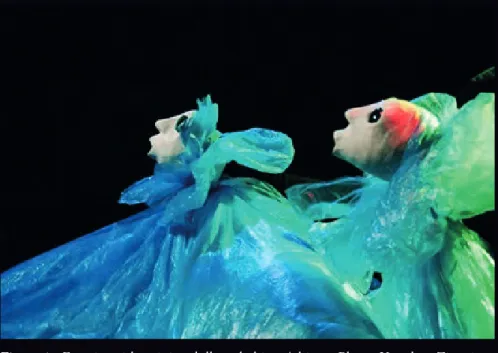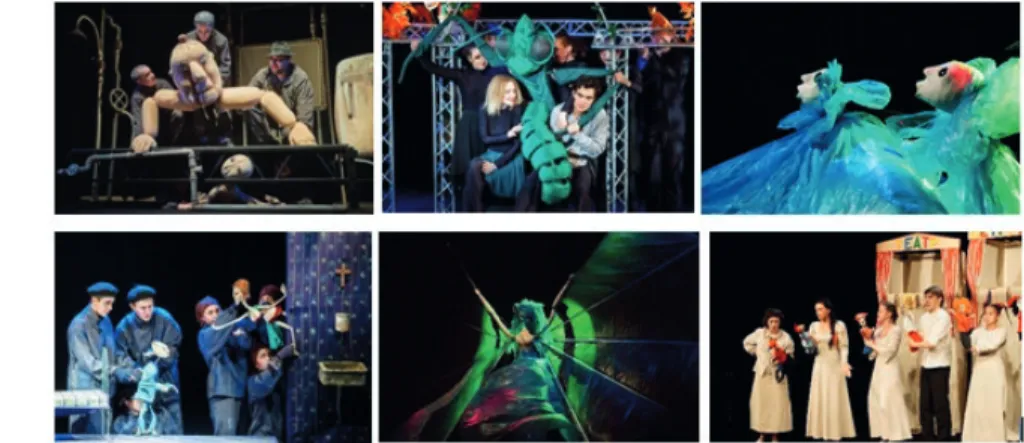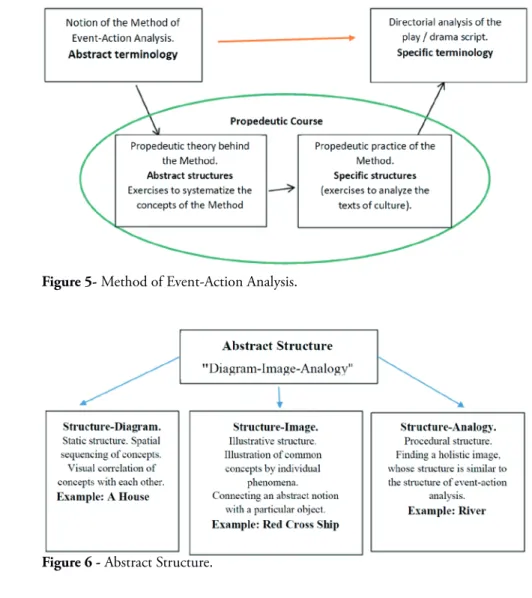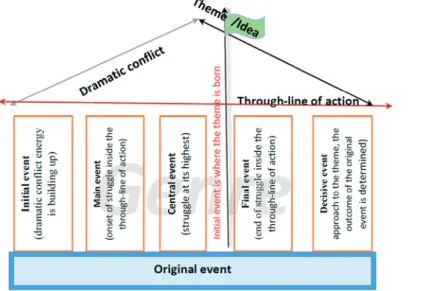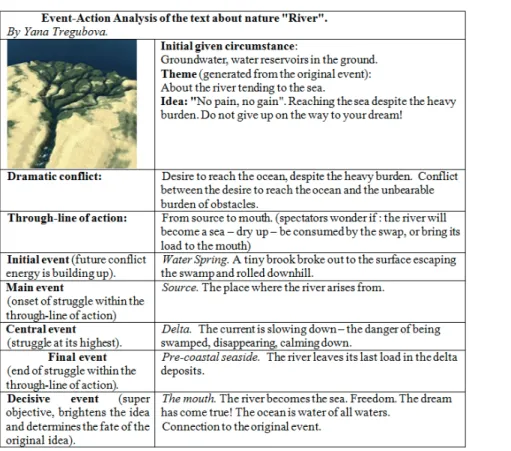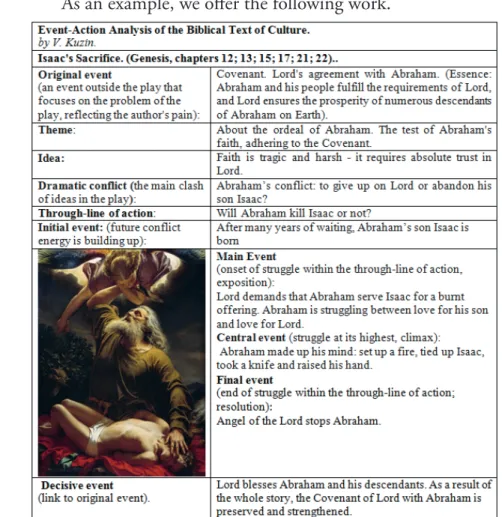in exercises of a mental experiment
Elmira Kurilenko
Novosibirsk State Th eatre Institute Drama School (Novosibirsk/Russia)
Figure 1 - Exercise with training dolls and objects/objects. Photo: Yaroslava Zinovieva e Victor Dmitriev.
R
evista de Estudos sobr
e Teatr o de F or mas Animada s DOI: http://dx.doi.org/10.5965/2595034702212019323
Abstract: The article actualizes the problem of mastering the Method of Event-Action Analysis by the students of theatrical schools. The author of the article proposes the propaedeutical practical stage of the Method application. The stage makes abstract and specific structures meet in the creative analyses of very different texts of culture like paintings, landscapes, historical events and even the laws of nature.The article offers the examples of creative works of the students of Novosibirsk drama school in application the Method of Event-Action Analysis to cultural texts.
Keywords: Director’s analysis of the text. Method of event and action analysis of the play. Retelling. Event line. Structure. Text of culture.
A puppet artist is a universally skilled artist. In our school, it is mandatory for an artist to master the four main puppet types as well as a number of drama, vocal, and body movement challenges. In the process of learning, our students make puppets and settings with their own hands, develop acting skills and get their first ex-perience in stage direction.
For convenience we can identify 4 stages of professional de-velopment.
Stage 1. Path to Yourself
Training period. Self-study stage.
All types of acting training, as well as exercises for plastic expressiveness of hands, controlling objects (sticks, rings, clubs, balls), for mastering training puppets.
Expected outcome: control of body, perception, emotions. Key feature: establishing a psychophysical connection with training puppets of key types.
R
evista de Estudos sobr
e
Teatr
o de F
or
mas Animadas
Figure 2 - Exercises with training dolls and objects/objects. Photos: Yaroslava Zinovieva e Victor Dmitriev.
Stage 2. Your Path to Partner
Time for Scene Studies and Acting Observations. Following a Cultural Model Stage.
Scene studies – interaction with a partner. Acting observations – mediated communication (interaction with cultural models).
Expected outcome: control of imagination, thinking, speech, freedom to follow cultural models.
R
evista de Estudos sobr
e Teatr o de F or mas Animada s
Figure 3 - Work with a doll and acting observations. Fotos: Yaroslava Zinovieva e Victor Dmitriev.
Stage 3. Path to Role (to the character and action)
Working on a role in a piece or a performance. Stage of trans-formation.
Expected Outcome: freedom of action and transformation, ability to act upon the director’s task.
Key Feature: ability to handle key types of puppets.
Figure 4 - Puppet shows of students, made under the direction of a director. Photos: Yaroslava Zinovieva e Victor Dmitriev.
R
evista de Estudos sobr
e
Teatr
o de F
or
mas Animadas
Stage 4. Path to the Author
Working on the text of culture. Interpretation Stage.
Expected outcome: the ability independently to make a direc-torial analysis of the texts of culture.
So, my presentation will cover Stage 4 – Path to the Author. Directing skills are very important, since puppeteers are more often than other actors create their own touring performances. This presentation reflects my experience of both a director and a teacher. Therefore, the other points of view on the key points of the report are possible.
Traditionally, the directorial analysis of the author’s text in our country is associated with the terminology of the Stanislavsky system and its followers. We study the play on the basis of the Method of Event-Action Analysis. Before they approach the Method, the students already have a primary understanding of the key notions of this Method. But they often confuse the meaning of some no-tions (the original event, the theme, the conflict, the through-line of action, etc.). They do not see the connections between them. Students’ knowledge is chaotic, rather than structured. They have not yet formed a holistic system of concepts. Understanding the whole helps understand the particular. After all, the general meth-odology principle says that the meaning of a concept is defined not only by the definition as such, but also by the placement of this concept inside a holistic system.
The Method of Event-Action Analysis in theatre institutes of higher learning is offered as a new professional thesaurus for students, its essence being explained to them. Following that, the Method is used as a basis for an independent analysis of the play. Let us review Figure 5.
R
evista de Estudos sobr
e Teatr o de F or mas Animada s
Figure 5- Method of Event-Action Analysis.
Figure 6 - Abstract Structure.
These exercises have no subject, only objects. However, focus on the plot is very important. In the future, when students will face dramaturgy challenges, they will have to prepare a brief outline of the play and examine the plot. The Method of Event-Action Anal-ysis does not contradict the terminology prevalent in the English speaking world regarding the analysis of the plot: exposition, the rising action, catastrophe (corresponds to the climax), falling action, resolution. The analysis of the plot, on the contrary, correlates with the Russian system of singling out the event line. However, only
R
evista de Estudos sobr
e
Teatr
o de F
or
mas Animadas
in the Russian system, the event line is subject to the articulated theme, the dramatic conflict, the through-line of action and spec-ification of the original event.
So, a brief outline of the play is necessary in order to discover your own attitude1 to the events and to determine the event line.
“The decision about which story to tell and why should be taken by the narrator, since the plot without a personal perspective will be just a succession of events” (BARTOW, 2006, p. 365). When an event line is identified, it is possible to formulate a theme, an idea, a dramatic conflict, and a through-line of action. How to visually connect all these concepts? Figure 7 allows you to structurally correlate the concepts of the Method of Event-Action Analysis.
Figure 7 - Abstract Structure -Diagram “House”.
1 M.I. Tumanishvili, in his manuscript Introduction to Direction, shows how a brief
outline of the play can clearly reveal the director’s attitude to the play (TUMANISHVI-LI, 1976). So one and the same well-known play by Molière, The Doctor in Spite of
Himself can become either a story about a simpleton Sganarelle, who is in trouble, then
R
evista de Estudos sobr
e Teatr o de F or mas Animada s
1. Prepare a brief outline to determine the event line.
2. Identify the original event because a house construction begins with a foundation. The original event is located outside of the play, as well as our foundation is located outside the house, in the ground.
3. The original event generates the theme of the future per-formance. The principal vertical line is the height of the house, or the image of the house.
4. To make your roof strong, you will have to solidly con-nect three items: the theme, the dramatic conflict and the through-line of action. If these concepts remain unconnect-ed with each other, then the analysis should be done again. 5. Identify the event line of the play to reflect your sense of
genre that fills a building like air. These events hold the whole story together.
6. Formulate an idea that will sound like a motto, a slogan, or a call to the audience. This will be your flag to march on with.
In the academic literature, the authors call events differently, but there is an objective basis behind their successive change. The logic is as follows: the original event is a kind of emotional “beginning” of a performance. It begins outside the performance and resolves before the audience. 1st event – positioning of forces, build-up of energy for the future explosion, or a conflict; 2nd event – struggle inside through-line of action (exposition); 3d event – the climax, the highest peak of the struggle inside through-line of action; 4th event – end of struggle inside through-line of action, the leading given circumstance has been exhausted (the resolution is obvious); 5th event – the final one, where the whole idea of the play is “bright-ened”; here the fate of the initial given circumstance is decided – we will find out what became of it, whether it has changed or remained the same. In the diagram above (Fig. 7), we used the terminology of the great Russian director G.I. Tovstonogov as stated by the theatre teacher and theorist I. B. Malochevskaya (2003).
R
evista de Estudos sobr
e
Teatr
o de F
or
mas Animadas
Using illustrative structures, students learn to compare the individual elements and come up with the given circumstances for a particular image and forms of similarity. Each element of the Structure-Image is likened to an element of a fictional given circumstance. Using the example of one of the creative works (Fig. 8), one can trace the logic of such assimilation.
Figure 8 - Abstract Structure-Image “Ship of the Red Cross”.
Initially, the student formulated the theme simply as Ship. What kind of ship is it? Is it fishing, military, pirate, or a refugee boat, etc.? It is a ship in general? This uncertainty blocks the possibility of a dialogue, the possibility of understanding. We try to draw the attention of students to the problem of formulating a theme, which, if formulated too generally (fear, freedom, love), can be a trap. The general theme should be narrowed down to become more specific in order to establish the dialogue with the audience. Otherwise, it will be similar to our ship, which has no defined image, goal, mission, or activity.
Suppose we choose the theme “Ship of the Red Cross”. We check the first group of linked concepts: the theme grows out of the original event. What can be an original theme? We come up with a plot– there is an outbreak of plague on the neighbouring` island. What purpose do we build a ship for? For the sake of saving lives.
R
evista de Estudos sobr
e Teatr o de F or mas Animada s
The next bunch of concepts that need to be tied into a tight knot: the theme, dramatic conflict, through-line of action. We look for correlation. The ship cannot get out due to a storm, but we have to take risks to save people’s lives. Then the through-line of action to be followed by the audience will be about the storm itself and the forces of nature. The dramatic conflict will focus around the necessity to venture on a dangerous journey despite the forecasts. Because lives of other people and of their own are at stake.
Accordingly, for the following bundle of concepts, namely the main, central and final ones that run through the through-line of action, we come up with events that might take place during the ship journey in the storm. Then the initial event will be something that is not a part of the journey itself, but rather a condition for the success of the whole mission – namely, stocking the ship with medicine. And finally, the decisive event is also outside the through-line of action (outside the storm), and it should clarify the idea and determine the fate of the original event. What circumstance does it suggest? Of course, the ship arrives at its destination, and all the sick people are cured. So the original event turns into a given circumstance (on island N there once was a plague).
As you can see, there are no characters in this story, which means there is no action or no clash of ideas, or struggling. The whole struggle unfolds in an abstract fashion – between an abstract ship and the forces of nature. In abstract structures there is still no drama, no people’s stories, but there is only the Method with its bare structure. These are like piano training scales, the scales that precede real music.
The following example does not yet introduce a person, a character. The method is applied to objects rather than subjects. Anything can become an object: a volcano, natural water cycle, a forest, a juicer, artificial intelligence, and many others things.
River.2 Brief outline, plot (helps identify the theme, reveal the
problem and one’s own attitude to the major events).
2 A brief outline is made using texts about rivers from an open Internet resource
R
evista de Estudos sobr
e
Teatr
o de F
or
mas Animadas
A river is a natural flowing watercourse from source to mouth. A river begins at a source. There are two alternatives for any river: to join another body of water, or become dry. Not every river runs to the sea. The river always carries particles. Before running to the sea the river slows down and loses its power, and in the process of transferring a huge amount of sedimentary material along its course, it turns into a delta.
A delta is lowland! Deltas contain relatively little water. Delta is the place where sedimentary material brought by the river is deposited.
Pre-coastal seaside is a shallow, alluvial formation of soils carried by the river.
The mouth is the place where the river runs into the sea or ocean. The ocean is the water of all waters.
R
evista de Estudos sobr
e Teatr o de F or mas Animada s
Please note that the creative works of our students do not claim to produce finite conclusions, but rather encourage debate and new suggestions.
The next stage of creative exercises for students is the transition from “Abstract Structures” to the exercises including “Specific Struc-tures” (paintings, parables, historical events, celebrity biographies, cartoons, and movies). These are also Texts of Culture (pictorial, body expression, mythology, music, etc.). So students from mastery of the Method as such go to the practical training stage, only using more specific material. The exercises “Specific Structures” are the final stage of propedeutic training. In fact, it is the initial practice of applying the Method, to prepare the students for work with a drama script.
As an example, we offer the following work.
R
evista de Estudos sobr
e
Teatr
o de F
or
mas Animadas
Performing a number of numerous creative tasks is an in-termediate stage for students before they will actually work with literary and dramatic texts of culture. By this time, students should possess a specific structural knowledge about the Method of the Event-Action Analysis. They must develop experience of thinking and formulating, which the majority of students currently lack, when they first approach reading drama scripts.
REFERENCES
BARTOW, Arthur (ed.) Training of the American Actor. Trans-lated from English. Moscow; 406 p.
MALOCHEVSKAYA, I. B. Tovstonogov Directing School. St. Petersburg: OOO Beresta, 2003, 158 p.
TUMANISHVILI, M.I. Introduction to Stage Directing: Just before the rehearsal. Manuscript. Almanac “Menon”. 1976, 269 p.
R
evista de Estudos sobr
e Teatr o de F or mas Animada s
